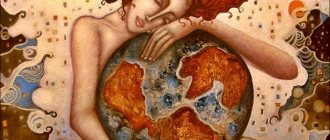In the early 40s. In the 19th century, a new direction in philosophy appeared - existentialism. The founder was the young Danish philosopher, writer and psychologist Søren Óbut Kierkegaard. At the center of the teaching is an original, unique personality who, in his own way, different from others, perceives the world around him, passing it through himself. Each person is viewed through the psychological situation in which he finds himself at a certain moment and which captures the emotional and spiritual depth of his problems. Later the ideas were picked up by such great minds as Nietzsche, Sartre, Heidegger.
At the beginning of the 20th century, existential psychotherapy appeared, which owes its birth to this philosophical trend. Its goal is to help everyone find the meaning of existence and find their place. This solves most problems not only mental, but also physiological.
The concept of existential psychotherapy
Existential psychotherapy is a set of rules and psychological approaches for returning a person to a normal life, full of worries and meaning. Here the emphasis is on awareness of oneself not as a separate object, closed in itself and its experiences, but as a part of being, the reality around. Therapy creates responsibility for one’s life and what happens in it. The term itself comes from the Latin existentia - “existence”. Existential psychology and psychotherapy closely overlap with philosophy. In the twentieth century, such a direction as the “philosophy of existence” arose, which is close in essence to existential psychotherapy.
The existential direction in psychotherapy originated thanks to Søren Kierkegaard. His teaching, which he worked on in the 1830s, became fundamental. Its main postulates said that man is inseparable from the outside world and social life. The main components of human existence are conscience, love, fear, care, determination. A person begins to realize his essence in extreme situations, such as death, struggle, suffering. By revaluing the past, a person becomes free. Kierkegaard introduced the concept of existence, a unique and one-of-a-kind human life, separate for each individual. He discovered a connection with turning points in fate and self-awareness, a different view of himself and life after the shock he experienced.
Existential therapy in the post-Soviet space
For 70 years, humanitarian thought in the USSR was separated by the “Iron Curtain” from the humanitarian thought of the rest of the world - the works of colleagues from other countries were not translated if they were non-Marxist, and foreign scientific periodicals were in special repositories of several leading libraries and it was impossible to gain access there very hard.
Under these conditions, humanitarian thought developed here, relying largely on its own cultural traditions. This also applies to existential praxis.
Existential praxis, created in the territory of the former USSR, is associated with two figures - psychiatrist, psychotherapist Alexander Efimovich Alekseychik, who lived and lives in Vilnius, and psychiatrist Andrei Vladimirovich Gnezdilov, living in St. Petersburg.
The direction of existential praxis associated with Alexander Efimovich Alekseychik arose in the late 60s of the last century. And from the mid-70s to this day, an annual (until 1992 All-Union, and after international) seminar has been operating in Vilnius under his leadership, in which its own original school of existential therapy has grown.
The direction is called Intensive Therapeutic Living (ITL). It is rooted in Russian existentialism. The key figures for him are F. Dostoevsky, N. Berdyaev, V. Rozanov, S. Levitsky, S. Frank, I. Ilyin, L. Shestov, Metropolitan Anthony of Sourozh
The most important thing for A.E. Alekseichik is the thesis of Metropolitan Anthony of Sourozh that if a person is seriously ill, it is impossible to recover in the same lifetime. You can only recover in another life, only by turning the steering wheel of your life. Because the roots of the disease go into the soil - into the way you live.
Disease is understood as a violation of the integrity of human life
- emphasis on its individual aspects,
- the disappearance of entire layers from it,
- alienation - turning one’s own life into someone else’s
The key for therapy is the presence of an image of a correct (healthy) life and God as the source of this image.
Because of this, the school of existential therapy of A.E. Alekseichik led a semi-underground existence in the USSR as an atheistic country; Alekseichik’s path to defending his doctoral dissertation was closed.
The experience of living in the USSR, where for several generations people learned not to express their thoughts, but to hide them, where what a person thinks very often did not correspond to what a person says, and what he says did not correspond to how he arrives, was reflected in existential therapy at the school of A.E. Alekseichik. Great importance is attached here to correlating what a person said with his actions, presenting the discovered inconsistencies to the patient.
Treatment proceeds as follows:
- creating a perspective for a person - what he could be,
- exit to “You”, to co-suffering, to helping each other, to paying for each other, to being for the sake of “You”, to the appearance of “We” - with the mutual meeting of beings for the sake of “You. Towards the formation of a therapeutic community
- promoting the emergence of courage to see your life not in time, but in eternity and in the light of this vision, reduce vanity, increase the weight of your words and deeds.
It happens that during life, diseases disappear, wounds heal. In Russia they say about this: “Time heals.” Mental wounds sometimes heal for decades.
In the IJT therapeutic group, the therapist sets himself the task of speeding up this process - so that the wounds heal in days, hours, minutes.
For this purpose, a lot of opportunities are created for people not to discuss their lives, but to live and manifest themselves. Any little things in people's manifestations become the subject of attention. The therapist helps the contradictions in a person’s life become apparent, helps the person face both those difficulties in his life with which he is familiar, and those that he will have to face if he does not change anything in his life. Often what happens is reminiscent of a person falling into a parable about himself.
In Alekseychik’s ITZ, anecdotes and ironic stories are often used, allowing clients to see the paradoxical nature of their life situation, recharge with self-irony and distance themselves from their positions in life.
The development of this direction by Semyon Yeselson, a follower of A.E. Alekseychik, founder and head of the board of the International Institute of Existential Counseling (Russia-Ukraine), led to the emergence of such a variety as a narrative tuning fork . Yeselson proceeds from the fact that many Soviet and post-Soviet people are characterized by a lack of internal spiritual and ethical supports. In the USSR, for almost 70 years, religious believers were persecuted, and the bearers of the new faith - believing communists - were virtually exterminated by the early 50s of the last century, during Stalin's repressions. And the Soviet people of the second half of the 20th century relied in their decisions on the ethics of new family and social traditions that were taking shape literally before our eyes. The collapse of the USSR destroyed these supports as well. And many of the difficulties in the lives of post-Soviet people, with which they come to existential consultants and therapists, are associated with uncertainty in the ethical dimension of their existence. The introduction during therapy of images of solving certain complex life conflicts in the Lives of the Saints or in the Holy Scriptures allows clients to relate to them as if they were a tuning fork and find support for solving their life difficulties. Here, for example, are the following topics - “The price of freedom in our life and in the life of the prophet Moses”, “Friendship and power in our life and in the life of St. Gregory, the Baptist of Armenia”, “Love and death in our life and in the life of St. Xenia Petersburg”, “Patience in our lives and in the life of St. Maximus the Greek”, etc.
The direction of existential praxis associated with Andrei Vladimirovich Gnezdilov originated in the 70s of the last century.
Andrey Vladimirovich - former head of the department of gerontopsychiatry at the Bekhterev Institute, chairman of the Association of Oncological Psychologists of Russia. Founder of the first hospice in the Soviet Union. Author of numerous psychotherapeutic tales. This therapy has roots in the “Silver Age of Russian culture” - the works of representatives of Russian humanitarian culture of the early 20th century, primarily in the practices of M. Voloshin.
The key to Gnezdilov’s therapy is the idea of the presence of a “wonderful dimension of existence” and the ability to solve the complexities of the patient’s life by addressing this dimension.
A significant part of Gnezdilov’s patients are seriously and terminally ill people. The whole reality of the surrounding world testifies to them that it is impossible to avoid death. Consciousness, logic, and the experience of an adult do not give any hope.
With the help of an existential therapist in the practice of A.V. Gnezdilov, a shift occurs in existential time and the time of childhood, childhood memory comes to the fore, people become like children with children's creative imagination, openness to the world, and trust in life. The possibility of believing in a miracle appears and those problems that are insoluble for adults begin to be resolved. The fear of death disappears. The ability to endure inevitable suffering is formed.
They help the therapist create a space for the patient to encounter a wonderful dimension of existence - therapeutic tales specially written for this patient, dolls, existential theater, bells, antique space, including costumes of all times and peoples, antique furniture and other antiques.
The last stage of a person’s life is seen by Gnezdilov as the culmination of life. Often, in the absence of fear of death, a person manages to formulate for himself the most important thing that he must manage to accomplish. The hand of death raised above him freezes, time stops, and the person manages to achieve it.
Existential therapists and counselors in the former USSR have been trained for a long time in three long-term training programs.
The first program introduces students to all areas of existential therapy that exist in the modern world. The program has been implemented since 1996 by the Institute of Existential and Humanistic Psychology (HEPI), in Birštonas (Lithuania). The program is led by Rimas Kociunas. The duration of training for existential therapists is 4 years. In addition, HEPI provides training for supervisors. The training program for existential therapists has been brought into compliance with the requirements of the European Association of Psychotherapy (EAP) for the European Certificate in Psychotherapy. In 2020, the Institute received accreditation as an educational institution from the EAP. At different times, HEPI had training groups in Moscow, Ivanovo (Central Russia) and Surgut (Russia, Siberia).
The second program continues the traditions of A.E. Alekseychik and A.V. Gnezdilov in existential therapy. The program has been implemented since 1999 by the International Institute of Existential Consulting (MIEK). The program is led by Semyon Yeselson. The duration of training for existential consultants is 4 years. Currently, the training system is being reorganized, increasing the duration of training to 6 years.
Today, MIEK training sites operate in Moscow, Rostov-on-Don, Nizhny Novgorod (Russia) and Kiev and Odessa (Ukraine). Until the spring of 2014, two more training sites of the Institute operated - in Donetsk and Sevastopol. MIEK educational programs are characterized by constant restructuring in connection with the peculiarities of life of a particular educational group, and differences in educational programs at different educational sites. In these programs, little attention is paid to erudition in the field of philosophy and psychology, but much attention is paid to world classics in the field of fiction and cinema, which help to see your life with its destructive, sick and creative, healthy tendencies - broader, more multifaceted. MIEK's motto is “Doctor, heal yourself.” This means that priority is given to therapeutic work with students
A feature of MIEK is creative search, the invention of new forms of existential praxis.
One of these new forms is existential theater therapy. Here is the entire theatrical process - from deciding who to be in the upcoming action (an actor in a certain role, a prompter, a director, a lighting designer, a decorator, a costume designer, a music director, a theater critic, a barman, etc.), with competition for certain roles and before analyzing what happened after the performance - become moments of the existential therapeutic process.
Another form developed at MIEC is the “Existential Journey”. This is an existential therapeutic group on the way, preparing group members for any event and summing up the meeting with this event
For example, there is a trip to St. Petersburg to A.V. Gnezdilov on the topic “Illnesses of loved ones.” The group is on the train on the way to Gnezdilov - work is underway with requests for a meeting with the Master. And the group is on the way back, where they are working with the results of the Meeting.
The third form of existential praxis, invented at MIEK, is the existential project “Memory of Future Generations”. The project involves the work of MIEC students and teachers to create their own family existential archives, which are based on the stories of older generations of relatives about the key stories of their lives. So that these stories turn into a message to their descendants - learning lessons from their lives and working on mistakes. In the course of this work, among other things, there is a transformation in the relationships of project participants with the older generations of their family. Attention to the life experience of older people on the part of their children, grandchildren and great-grandchildren often opens up new meanings for them and dramatically improves their mental and physical health.
MIEK is also characterized by its adherence to a special position in existential philosophy, formulated by S.B. Yeselson under the name “Radical existential worldview . This concept draws a strict divide between psychology and psychotherapy, between existential therapy and other areas of psychotherapy, formulates the ontological status of the life world and the ensuing consequences for existential therapy.
In addition to the long-term HEPI and MIEK training programs, several programs of Institutes based in Central European countries are being developed in Eastern Europe.
Thus, from 1999 to the present day, a long-term training program for the training of existential analysts GLE-Internationa l, Vienna (directed by Alfred Längle) has been operating in Moscow. The duration of training for existential analysts is 4 years. In 2012, the GLE-International educational program began operating in Kyiv (Ukraine) and Riga (Latvia).
In 2013, an educational project for training logotherapists at the Viktor Frankl Institute in Vienna, Austria (directed by Alexander Batthyány) was launched in Moscow. The duration of training for logotherapists is 2 years.
In 2020, the Institute of Dasein Analysis was created in Minsk (Belarus), which plans to implement a long-term program for training dasein analysts. The scientific leadership of the Institute is carried out by Alice Holzhey-Kunz (Switzerland, President of the Swiss Society of Hermeneutical Anthropology and Dasein Analysis).
In 2020, through the efforts of professor of existentialist psychologist O.V. Lukyanov and his followers, the Siberian Institute of Phenomenological and Existential Psychology was organized in Kemerovo (Russia, Siberia). The Institute plans to create its own long-term training program for existential therapists.
existential fencing has become widespread in Russia . Since 2002 The training of specialists in existential fencing is organized by existential therapist Vyacheslav Letunovsky , a graduate of the Calfred Durkheim School of Existential Education and Initial Therapy (Toodmos-Rütte, Germany). Praxis is based on the thesis - how you fence is how you live. Everything that happens during fencing becomes the subject of detailed existential analysis. Duration of training – 2 years.
Around three long-running long-term training programs for existential counselors and therapists (HEPI, MIEK and (GLE - INTERNATIONAL) programs), three large communities of existentialist practitioners have emerged - the Eastern European Association of Existential Therapy, the MIEK Community and the Existential-Analytical Association.
The Eastern European Association of Existential Therapy holds annual conferences in Birštonas (Lithuania), and the MIEK Community has held annual festivals in Crimea (Cape Tarkhankut), and since 2014 - in Belarus (Baranovichi). Participants of the Existential-Analytical Association gather once every two years at the GLE – INTERNATIONAL conference.
Each of these communities publishes its own magazines in Russian. Since 2002, the journal “Existential Tradition: Philosophy, Psychology, Psychotherapy” has been published (editor-in-chief S.B. Yeselson). The magazine is published 2 times a year. This is the magazine of the MIEC Community.
It is published with the support of the Institute of Existential Analysis and Life Creativity (director - D.A. Leontyev).
Since 2008, the magazine “Existentia” has been published - this is the magazine of the Eastern European Association of Existential Therapy. The magazine is published once a year.
Since 2009, the newsletter “Existential Analysis” has been published - the journal of the Existential-Analytical Association.
In 2001, MSU professor and existentialist psychologist Dmitry Leontyev created the Institute of Existential Psychology and Life Creativity. The main achievement of the Institute was the organization of all-Russian conferences on existential psychology with international participation once every three years. These conferences have become the only platform where existential therapists and consultants of different directions, practicing in the territory of the former USSR, as well as existentially oriented philosophers and teachers meet.
Bugental's postulates
James Bugental is president of the Association for Existential Psychotherapy. In 1963, he identified the basic concepts of existential psychotherapy:
- Man is a holistic being that must be assessed and studied in the sum of all its components. In other words, partial functions cannot serve to assess personality, only all factors as a whole.
- Human life is not isolated, but tied to interpersonal relationships. A person cannot be studied without taking into account his experience of communication.
- It is possible to understand a person only by taking into account her self-awareness. The individual continuously evaluates himself, his actions, and thoughts.
- A person is the creator of his life, he is not an outside observer, past whom pictures of existence fly by, but an active participant in the action. He creates the resulting experience himself.
- A person’s life has meaning and purpose, his thoughts are directed to the future.
Existential psychotherapy is aimed at studying a person in life, in the world around him, with his life situations. Each of us gains our own life experience in communicating with the world around us, with other people. This forms our psychological picture, without which it is impossible to help the patient in psychotherapy. A set of personal qualities will not give full awareness of the individual, a person does not live in isolation, inside his cocoon, he is constantly developing, changing forms of behavior, assessing the environment and, based on this, performing certain actions. Therefore, some psychologists avoid the concept of personality, since it does not allow us to fully study all aspects of human existence and consciousness.
Goals of therapy
Existential psychotherapy aims to direct a person’s thoughts in the right direction, help to understand life, understand its importance and all the opportunities provided. The therapy does not involve changing the patient's personality. All attention is directed precisely to life itself, to rethinking certain events. This makes it possible to take a fresh look at reality, without illusions and speculation, and make plans for the future and define goals. Existential psychotherapy determines the meaning of life in everyday worries, responsibility for one’s own life and freedom of choice. The ultimate goal is to make it harmonious by creating a new view of existence. We can say that therapy helps you understand life, teaches you to confront problems, find ways to solve them, explores all the possibilities for improving your existence and encourages action. Patients are not perceived as sick people, but as those who do not know how to rationally use their capabilities, and who are tired of life. If a person is confused in life and his thoughts, it is a big mistake to treat him as if he were sick. This is what representatives of existential psychotherapy think. You cannot treat him as a helpless person, you just need to help him rethink what is happening around him and choose the right path along which he will go into the future meaningfully and with a specific purpose. The goal is not to change the personality, but after undergoing therapy, a person may understand that he needs to change something in order to improve his life, that now he is not living the way he wants, because decisive action is needed. Existential psychotherapy is an opportunity to gain knowledge and freedom, strength, patience. It teaches you not to close yourself off from reality, not to hide from problems, but to study and feel life through suffering, experiences, disappointments, but to perceive them adequately.
Awakening a sense of responsibility for your decisions
When this problem arises, it will be effective to identify ways of refusing responsibility (using confrontation interviews, paradoxical statements, etc.). Therapy aimed at awakening responsibility, like all existential therapy, excludes the directive style - because in this case there is a great danger of transferring responsibility to the therapist - another trick of the client. Therapy methods should be aimed at strengthening volitional qualities (or awakening them); it is important to take into account personal potential, build goals and desires in order to then translate them into reality, thinking about how this can be done. If there are “no” desires, there is work to be done to find oneself, to feel the client’s taste for life.
Psychotherapy and philosophy
Now it becomes clear why the existential tradition in psychotherapy originated from philosophy, and why it is closely interconnected with it. This is the only psychotherapeutic teaching whose principles are substantiated by philosophy. The founder of existential teaching can be called the Danish thinker Soren Kierkegaard. Other Western philosophers who made a great contribution to the development of the existential school: German philosopher, classic of existential philosophy M. Heidegger, as well as M. Buber, P. Tillich, K. Jaspers, French philosopher Sartre and many others. Over time, existential psychotherapy has become widespread. Representatives of Russian philosophy also did not stand aside and invested no less effort and knowledge into existential teaching. These are V. Rozanov, S. Frank, S. Trubetskoy, L. Shestov, N. Berdyaev.
For the first time, the Swiss psychoanalyst L. Binswanger decided to combine philosophy and psychotherapy. He made such an attempt in the 30s of the twentieth century, proposing an existential approach to psychotherapy. The paradox is that he did not practice this area, but was able to determine the basic principles of a person’s inner world, his behavior and reaction to the surrounding reality, and lay the foundations of therapy. He can be called the founder of existential psychotherapy. Medard Boss, a Swiss psychiatrist, proposed his concept, the first of its kind. This happened in the 50s of the twentieth century. He took the teachings of the German philosopher Heidegger as a basis and transformed them for use in psychotherapy. He is considered the founder of one of the areas of existential therapy - Dasein analysis, which contains a model of understanding a person. In the 60s, Boss organized a training program for psychoanalysts and psychotherapists using his own methods. Existential psychotherapy now has many currents, its techniques differ, but they have one goal - to make a person’s life comfortable and of high quality.
Loss of meaning in life
Such problems often arise in adolescence - or later, at turning points. Here it is important to stimulate the client’s self-expression, to shift the angle of perception from a focus on internal processes to the outside in order to gain meaning (sometimes a narrowed perception drives a person into a dead end). This is facilitated by visits to orphanages, hospices, volunteer work, and any appeal to someone else’s, even more dramatic, experience. Often a person who feels abandoned and lonely, useless to anyone, brightens simply from the eyes with which his children, deprived of parental care, greet and see him off, and realizes his own importance, relevance, and need on a non-verbal level.
It will also be important in the therapy process to think together about different aspects of events, taking into account V. Frankl’s principle: all events are neutral, and only a person colors them in light or dark tones. Flexibility of thinking is an important quality both in therapy and during the patient’s subsequent self-help. If we take as a postulate the belief that there is no only bad or unambiguously good in life, this in itself will have an important therapeutic effect.
And it is quite possible that the most important thing in existential therapy is what Irvin Yalom spoke about - the manifestation of participation in the client, involvement in his life and the meanings with which it is filled. Attitude therapy is a powerful weapon in the hands of a psychologist. Who knows, maybe this is the client’s last opportunity to be unconditionally accepted and heard.
Frankl's psychotherapy
One of the most typical representatives of existential psychotherapy is Viktor Frankl. This is an Austrian psychologist, psychotherapist and neurologist. Existential psychotherapy, the methods of which are based on the teachings of Frankl, is called logotherapy. His main idea is that the main thing for a person is to find the meaning of existence and understand his life, he should strive for this. If a person does not see the meaning, his life turns into emptiness. Frankl's existential psychotherapy is based on the understanding that existence itself poses questions to a person about the meaning of existence, and not vice versa, and a person needs to answer them with actions. Existentialists believe that each of us can find meaning, regardless of gender, age, nationality or religion, or social status.
The path to meaning is individual for every person, and if he cannot find it himself, therapy comes to the rescue. But existentialists are confident that a person himself is able to do this; they call the main guide conscience, which Frankl considered “the organ of meaning,” and called the ability to find it self-transcendence. An individual can get out of a state of emptiness only by interacting with the surrounding reality; It is impossible to do this by withdrawing into yourself and focusing on your inner experiences. Frankl argued that 90% of drug addicts and alcoholics became like this due to the loss of the meaning of life and the loss of the path to it. Another option is reflection, when a person focuses on himself, trying to find happiness in this; this is also a false path. Logotherapy developed by Frankl is based on counteraction to reflection - dereflection, as well as paradoxical intention.
Definition and main ideas of existential psychology
Existential psychology is based on a philosophical approach and is the process of finding value and meaning in life. It is based on the idea that a person is not a victim of circumstances, but is responsible for his own actions and choices, thereby shaping reality.
Existential psychology takes a positive approach that celebrates human aspirations and abilities while recognizing human limitations. This branch of psychology helps people come to terms with the basic principles of human existence, the so-called givens. There are 4 main existential givens:
- Freedom and the responsibility associated with it. Everyone has freedom of choice. Every decision has consequences, no matter how big or small. To grow, a person must take responsibility, i.e. become the author of your own choices, actions and life. However, many people strive for freedom while trying to avoid responsibility.
- Death. Death is one of the absolute truths of life. Everyone will die at one time or another.
- Loneliness. On the one hand, a person is a social being who desires constant contact with others, on the other hand, he is absolutely alone, because he cannot count on 100% understanding and acceptance of his individual experience by other people.
- Pointlessness. There is no meaning to life. This means that there is no predetermined value. The meaning of life is different for everyone, and each person must find that meaning through their own choices and actions.
The struggle with any of these givens causes intrapersonal conflict and fills a person with fear or existential anxiety. For example, for most people the fact of their own death or the death of relatives is a source of deep anxiety; they persistently ignore reality and refuse to accept the fact that death will occur. There are also those who, to the point of neurosis or psychosis, are fixated on the inevitability of death.
Existential psychology offers a solution: to accept the inevitability of death, being free from its pressure. People who maintain a healthy balance are motivated to make decisions that positively impact their ongoing lives. The reality of death encourages us to make the most of opportunities and appreciate what we already have.
Living an authentic (genuine) life, realizing one’s unique properties and potential is the main call of existential psychology. This can only be achieved by taking responsibility for your own actions and idleness, realizing that inaction is also a decision.
Existential psychology reminds us of the limited time, stimulates us to look for the meaning of life and act in such a way that fate is in the hands of a person. She accepts the inevitability of “normal” anxiety, considering it part of growing up and an adequate reaction to what is happening.
Methods of logotherapy. Dereflexion
Dereflection involves complete surrender to the outside, stopping delving into one’s own experiences. This method is used in the presence of obsessive-compulsive neuroses. An example of such violations is often problems in sexual life associated with fear of impotence and frigidity. Frankl believed that obsessive-compulsive neuroses of a sexual nature are associated with the desire to receive pleasure and the fear of its absence. Trying to find happiness, constantly concentrating on it, a person does not find it. He goes into reflection, observing himself as if from the outside, analyzing his feelings and ultimately not receiving any satisfaction from what is happening. Frankl sees the solution to the problem as getting rid of reflection, self-forgetfulness. As an example of the successful application of the dereflection method in Frankl's practice, one can highlight the case of a young woman who complained of frigidity. She had been abused in her youth and was constantly afraid that this would affect her sex life and her ability to enjoy it. And it was precisely this focus on oneself, one’s feelings and emotions, digging into oneself that provoked the deviation, but not the fact of violence itself. When the girl was able to switch attention from herself to her partner, the situation changed in her favor. She was able to enjoy sexual intercourse and the problem disappeared. The range of applications of the dereflection method is wide and can be useful in solving many psychological problems.
Paradoxical intention
Paradoxical intention is a concept based on Frankl’s teachings about fears and phobias. He argued that a person’s fear of some event, turning into an obsessive state, gradually leads him to exactly what he is afraid of. For example, an individual becomes poor or sick because he experiences the emotions and feelings of such a person in advance, being afraid of becoming one. The term “intention” comes from the Latin intentio – “attention, desire”, which means internal direction towards something, and “paradoxical” means the opposite of action, contradiction. The essence of this method is to deliberately create the situation that causes fear. Instead of avoiding any circumstance, you need to meet it halfway, this is the paradox.
You can give an example with a scene. A man, once performing on stage in front of an audience and being nervous, noticed that his hands were shaking. The next time, before going out, he began to fear that his hands would shake again, and this fear came true. Fear begets fear, as a result, all this turned into a phobia, the symptoms were repeated and intensified, and a fear of waiting appeared. In order to get rid of this condition and live calmly, enjoy life, it is necessary to eliminate the root cause of fear. The method can be applied independently, having formed a clear intention to create a situation opposite to the one from which you would like to get rid of. Let's give a couple of examples.
One boy wet himself every night in his sleep, and his therapist decided to use the method of paradoxical intention on him. He told the child that every time this happened again, he would receive a reward. Thus, the doctor transformed the boy’s fear into a desire for this situation to happen again. So the child got rid of his illness.
This method can also be used for insomnia. A person cannot sleep for a long time, the fear of a sleepless night begins to haunt him every evening. The more he tries to understand his feelings and tune in to sleep, the less successful he is. The solution is simple - stop delving into yourself, being afraid of insomnia, and plan to deliberately stay awake all night. Existential psychotherapy (the use of paradoxical intention in particular) allows you to take a fresh look at the situation and gain control over yourself and your life.
Client-centered method
Another area that includes existential psychotherapy. The basic concepts and techniques of its application differ from the classical ones. Client-centered therapy was developed by American psychologist Carl Rogers and described in his book Client-Centered Therapy: Current Practice, Meaning, and Theory. Rogers believed that a person in his life is guided by the desire for development, professional and material growth, while using available opportunities. He is designed in such a way that he must solve problems that arise before him and direct his actions in the right direction. But this ability can only develop in the presence of social values. Rogers introduced concepts that define the main criteria for personality development:
- Field of experience. This is the inner world perceived by a person, through the prism of which he perceives external reality.
- Self. Uniting physical and spiritual experience.
- I am real. Ideas about yourself based on life situations and the attitudes of people around you.
- I am perfect. How a person imagines himself if he realizes his potential.
The “real self” strives for the “ideal self.” The fewer differences there are between them, the more harmonious an individual feels in life. According to Rogers, adequate self-esteem, a person’s acceptance of himself as he is, is a sign of mental and mental health. Then they talk about congruence (internal consistency). If the difference is large, a person is characterized by ambition and pride, overestimating his capabilities, and this can lead to neuroses. The real Self may never get closer to the ideal due to life circumstances, insufficient experience, or because a person imposes on himself attitudes, behavior patterns, and feelings that distance him from the “ideal Self.” The main principle of the client-centered method is the tendency towards self-actualization. A person must accept himself as he is, acquire self-respect and strive for growth and development within limits that do not violate his self.
Dealing with Loneliness
Paradoxically, to cope with loneliness, you need to go deeper into it. As psychologists say, you cannot stop being lonely without the possibility of solitude.
In his work, the therapist will definitely focus on the client’s idea of a partnership that excludes manifestations of dependence and manipulation (if this idea is very approximate, they work on it). As a rule, the client often has a distorted image of a partnership or being in a couple; pathologies often manifest themselves in the form of an aggressive desire to possess a partner, to tell him what to do correctly, to manipulate, or, conversely, the mechanism of “sacrifice”, codependency, etc. is activated.
An important role in the work is played by the “here and now” attitude - in relationships with the therapist, the reasons for loneliness or difficulties in interpersonal interaction always appear. It will be a valuable experience for the client to receive “feedback” from the therapist.
Client-Centered Method Techniques
The existential approach to psychotherapy according to the Carl Rogers method identifies seven stages of development, awareness and self-acceptance:
- There is a detachment from problems, a lack of desire to change your life for the better.
- A person begins to show his feelings, express himself, and reveal his problems.
- Development of self-expression, acceptance of oneself with all the complexity of the situation, one’s problems.
- There is a need for originality, a desire to be yourself.
- Behavior becomes organic, spontaneous, easy. Inner freedom appears.
- A person opens up to himself and the world. Classes with a psychologist can be cancelled.
- The emergence of a realistic balance between the real self and the ideal self.
The main components of the method are identified:
- reflection of emotions,
- verbalization,
- establishing congruence.
Let's briefly look at each of them.
Reflection of emotions. During the conversation, the psychologist names out loud the emotions that the client experienced in a given situation, based on his story.
Verbalization. The psychologist retells the client’s messages in his own words, but does not distort the meaning of what is said. This principle was created to highlight the most significant parts of the client’s narrative, the most disturbing moments.
Establishing congruence. A healthy balance between the real and ideal self. The rehabilitation process can be considered successful if the client’s condition changes in the following direction:
- perceives himself adequately, is open to other people and new experiences, the level of self-esteem returns to normal;
- operational efficiency increases;
- realistic view of problems;
- vulnerability decreases, adaptability to the situation increases;
- reduction of anxiety;
- change in behavior in a positive direction.
Rogers' technique is quite successfully used in school with teenagers, in conflict management. It also has a contraindication - its use is undesirable if a person really does not have the opportunity to grow and develop.
Awareness of death
There is a belief that people who have experienced clinical death or serious illness value their lives more deeply and achieve a lot. Realizing the inevitable finitude of existence, death, existential psychotherapy forces you to rethink your attitude towards the entire world around you, to perceive reality in a different light. Usually a person does not constantly think about death, but when faced with a serious illness, he may behave inappropriately. For example, close himself off from others, withdraw into himself, or begin to take revenge on all the healthy people around him. The psychologist’s work using this method should lead to the client’s acceptance of the disease as an opportunity for personal growth. For a prepared person, the proximity of death leads to a reassessment of values and concentration on the present moment. He opens up to other people, his family and friends are no exception: relationships become close and sincere.
Existential psychotherapy, whose death awareness techniques may seem gloomy to some, actually helps many people overcome the difficulties that have happened to them with dignity.











